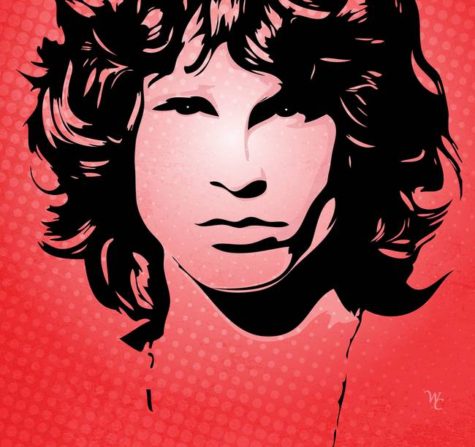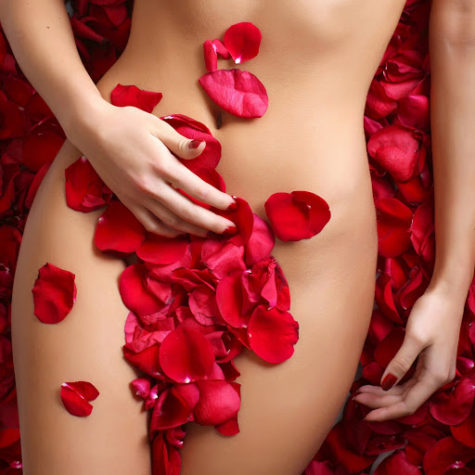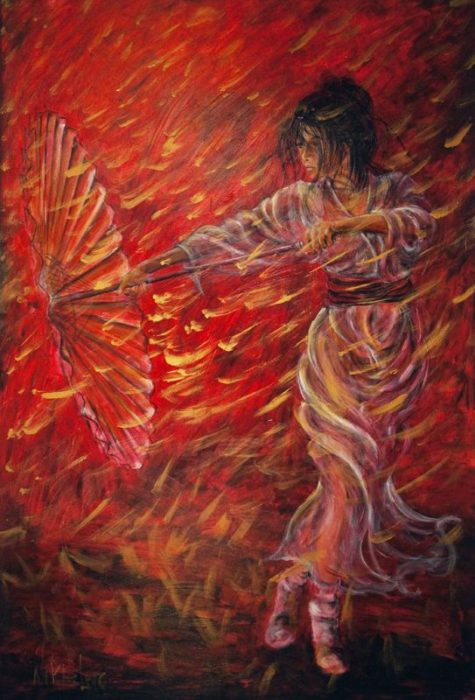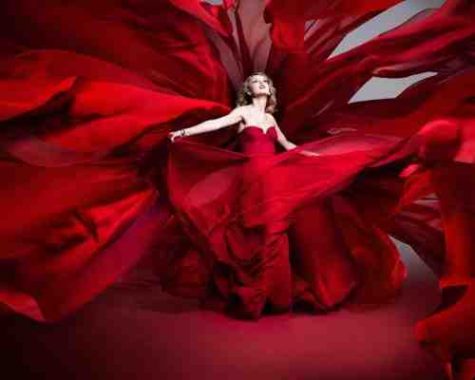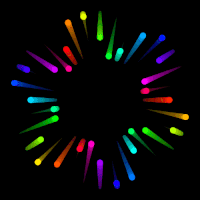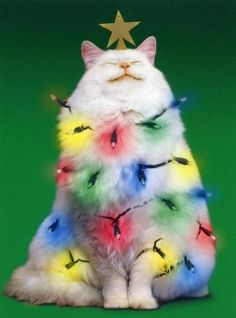Sexuality
Feeling Red
Phrases like “red light district” and “scarlet woman” aptly describe the sexual nature of red. Some aspects of red behavior are not socially acceptable. Red together with black is associated with evil, for example in the archetypal “red devil” of medieval artists.
Blatant expression of emotion is not always easy to handle, whether it is sexuality, passion, anger or aggression. When expressing red emotions, the heart beats faster, the capillaries dilate and the skin becomes flushed and feels warm.
Red is thought of as an immediate color. This affects the thinking processes, causing restlessness and impatience. Red can result in very selfish behavior, a focus on personal needs and survival above everything else.
Sometimes the drive to survive is what fuels impulsive actions and rash comments. When these traits are managed well they create capable business people who are innovators and entrepreneurs, preferring to move from one project to another, getting an operation on its feet then moving on. They are gifted with being able to manifest new ideas. Often people with red traits are also renowned for their daring exploits, and they can be somewhat extroverted and boastful about their skills.
Red brings focus to the physicality of life, to the process of living. The color is symbolic of what we need to survive. Life should be grabbed and lived with a sense of immediacy. Without red we become listless and out of touch with reality and we fail to live our dreams in this world. Without the foundation that red gives us we just daydream of escaping into fantasy worlds.
Source unknown
Red On Women Drives Men Wild
Red may be the color of love for a reason: It makes men feel more amorous towards women, a new study reports.
From ancient rituals to those red paper lace hearts on Valentines, red has been tied to carnal passions and romance in many cultures over the course of history.
In five psychological experiments, University of Rochester psychologists tested how different colors affected men’s attitudes towards women.
In one experiment, test subjects were shown a picture of a woman that was framed by either a red or white border and asked to answer a series of questions, such as: “How pretty do you think this person is?” Other experiments contrasted red with gray, green or blue (keeping saturation and brightness levels the same between the different hues).
In the final study, the shirt of the woman in the photo was digitally colored red or blue. In this experiment, men were questioned not only about their attraction to the woman, but about how they would plan a hypothetical date with her. For example, one question asked: “Imagine that you are going on a date with this person and have $100 in your wallet. How much would you be willing to spend on your date?”
In all the experiments, women shown framed by or wearing red were rated significantly more attractive and sexually desirable by men than the exact same women shown with other colors.
When wearing red, women were also more likely to be treated to a more expensive outing.
“It’s fascinating to find that something as ubiquitous as color can be having an effect on our behavior without our awareness,” said study team member Andrew Elliot.
The study, detailed in the Oct. 28 online edition of the Journal of Personality and Social Psychology, is said to be the first to scientifically document the effects of color on behavior in relationships.
Elliot and his co-author Daniela Niesta said the effect could be due to societal conditioning, though they attribute it to deeper biological roots because nonhuman male primates, such as baboons and chimpanzees, are known to be attracted to females displaying red.
The red effect applied only to males and only to their perceptions of attractiveness; it did not change their ratings of the pictured women in terms of likability, intelligence or kindness.
Other research suggests that the effect of color depends on the context. In a previous study, Elliot and his colleagues showed that seeing red in competitive situations, such as sporting events, leads to worse performance. Another recent study suggests that referees favor red-clad competitors because of a subconscious bias for the color.
Using The Color Red
“As she always did on any really important day, Penelope Hayes wore red.”
― Anna Godbersen
Wearing red:
A person may choose to wear red one day and this may indicate they are ready to take action, or they may be passionate about what they are going to do that day, or again it may mean that they are feeling angry that day, on either a conscious or subconscious level. Wear a red accent piece when you want to present yourself as bold and dynamic. It can boost your confidence if you are attending a function or interview where you feel unsure of yourself. If a woman wears a red dress it usually is associated with sex appeal.
Put red in your life when there is:
- A lack of enthusiasm and interest in life.
- A lack of energy and a feeling of over-tiredness.
- An inability to make your dreams a practical reality.
- A feeling of insecurity, unwarranted fear, or anxiety.
- Deficiencies in red and red foods show up as low energy levels, anemia, light-headedness, and lack of stamina.
Questions to ask yourself when drawn to the color red:
- Is there a need to take action now?
- What is stopping you from doing what is necessary?
Loving red:
People who love the color red act – sometimes without thinking – on immediate desires. In fact, they’re usually the poster children for immediate gratification. Sometimes people who love red are at war with themselves or others, their lives, and/or circumstances. Red is associated with passionate love, sex, great energy, impulse, action and stimulation, assertiveness and aggression, courage, strength and power, adventure, danger, warnings, revolt and revolution. Temperamental and ambitious people with a need for personal freedom.
Not loving red:
A person who has an aversion to red may be over-active, too impulsive, hot-tempered, aggressive and egocentric, or have difficulties with people with such characteristics. It can also symbolize deeply hidden fears and rejection of his own assertiveness.
Note: This post was compiled by Shirley Twofeathers for Color Therapy, you may repost and share without karmic repercussions, but only if you give me credit and a link back to this website. Blessed be.
The Color Red
“Red is the color of life. It’s blood, passion, rage. It’s menstrual flow and after birth. Beginnings and violent end. Red is the color of love. Beating hearts and hungry lips. Roses, Valentines, cherries. Red is the color of shame. Crimson cheeks and spilled blood. Broken hearts, opened veins. A burning desire to return to white.”
― Mary Hogan, Pretty Face
One of the three primary colors, bright red pops out of whatever environment it happens to be in and grabs our attention more than any other color. Moreover, it is the first actual color that is seen by babies. Because it has a lower vibrational frequency than any other color in our visible spectrum, it is associated with the base chakra and symbolizes passion, sexuality, fertility, and animal urges.
Red is thought of as an immediate color. This affects the thinking processes, causing restlessness and impatience.
The effect of red on the eye is quite unusual. For the color to be seen, the eye itself makes internal adjustments. This alteration means that we see red objects as closer than they really are.
Red is the color of blood, rubies and strawberries. This primal color is associated with danger, sacrifice, passion, fire, beauty, blood, anger, Christmas, socialism, communism, and in China and many other cultures, with happiness. Red is the color of blood, which means that it is associated with the life-force and vitality. Red is the most physical active color, a color of personal self-hood (I AM), red is a color of will. It supports survival and leadership.
Wearing red, eating red foods and surrounding yourself with red increases the body’s ability to absorb iron, the metal that is responsible for the color of hemoglobin in the blood. The presence of hemoglobin allows the blood to absorb oxygen in the lungs and to transport that life-giving oxygen to the cells of the body.
Red light increases blood pressure, pulse rate, and breathing rate. Psychological research has shown that men find women who are wearing red more attractive. Bright red rooms often make people anxious. Rooms with a red toned accent can influence people to lose track of time, this is one reason why red is often used in bars and casinos. Restaurants often use red as a decorating scheme because it stimulates the appetite.
Red is the color of passion, anger, and high blood pressure. Red is a primal color. It represents primal urges, like lust (we call certain areas red-light districts for a reason) and fury (you know the phrase “seeing red,” right?). Yes, red is a commanding color: think of how stop signs get you to halt in your tracks and how you stand back when a red fire engine goes whizzing by.
Note: This post was compiled by Shirley Twofeathers for Color Therapy, you may repost and share without karmic repercussions, but only if you give me credit and a link back to this website. Blessed be.
